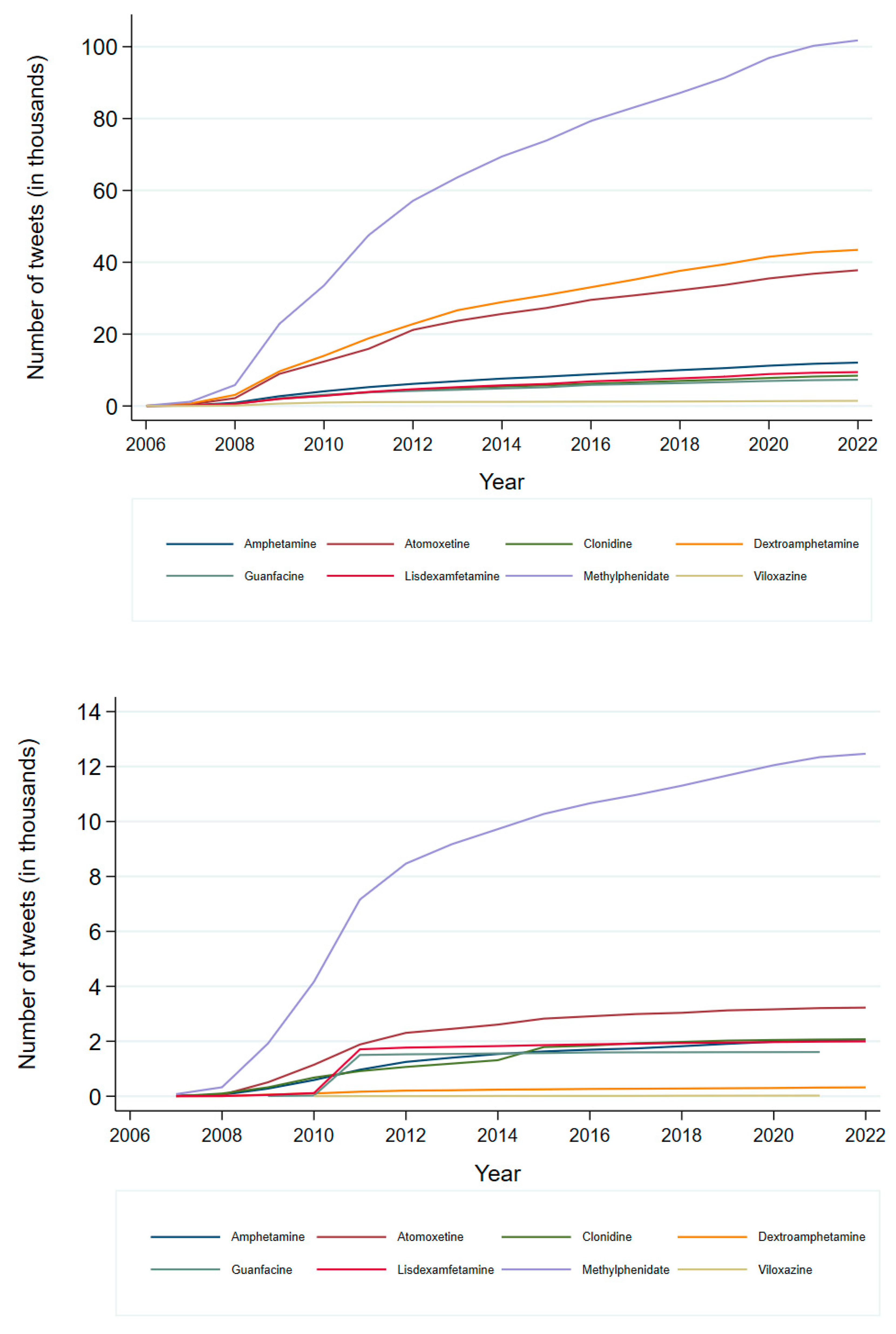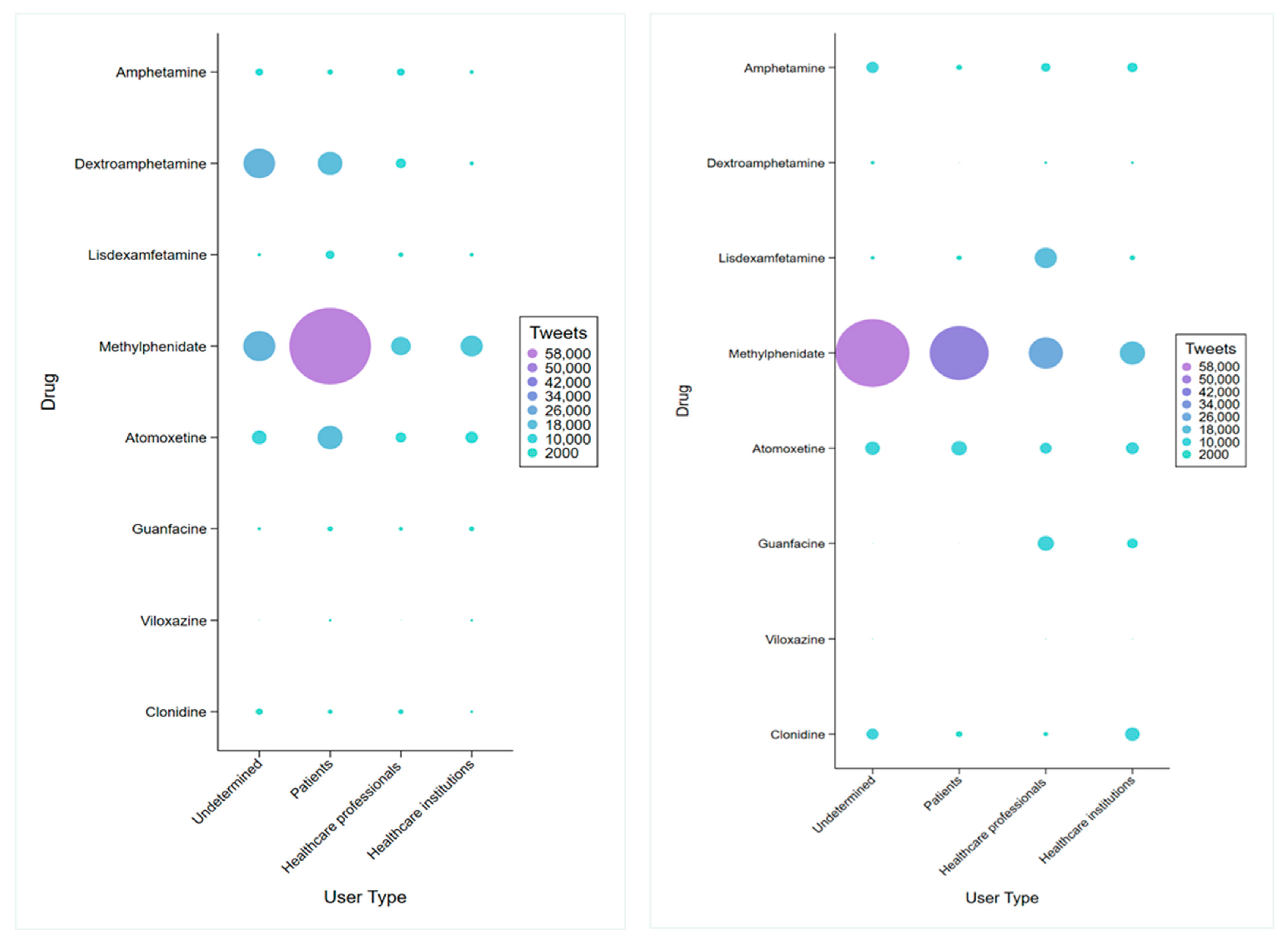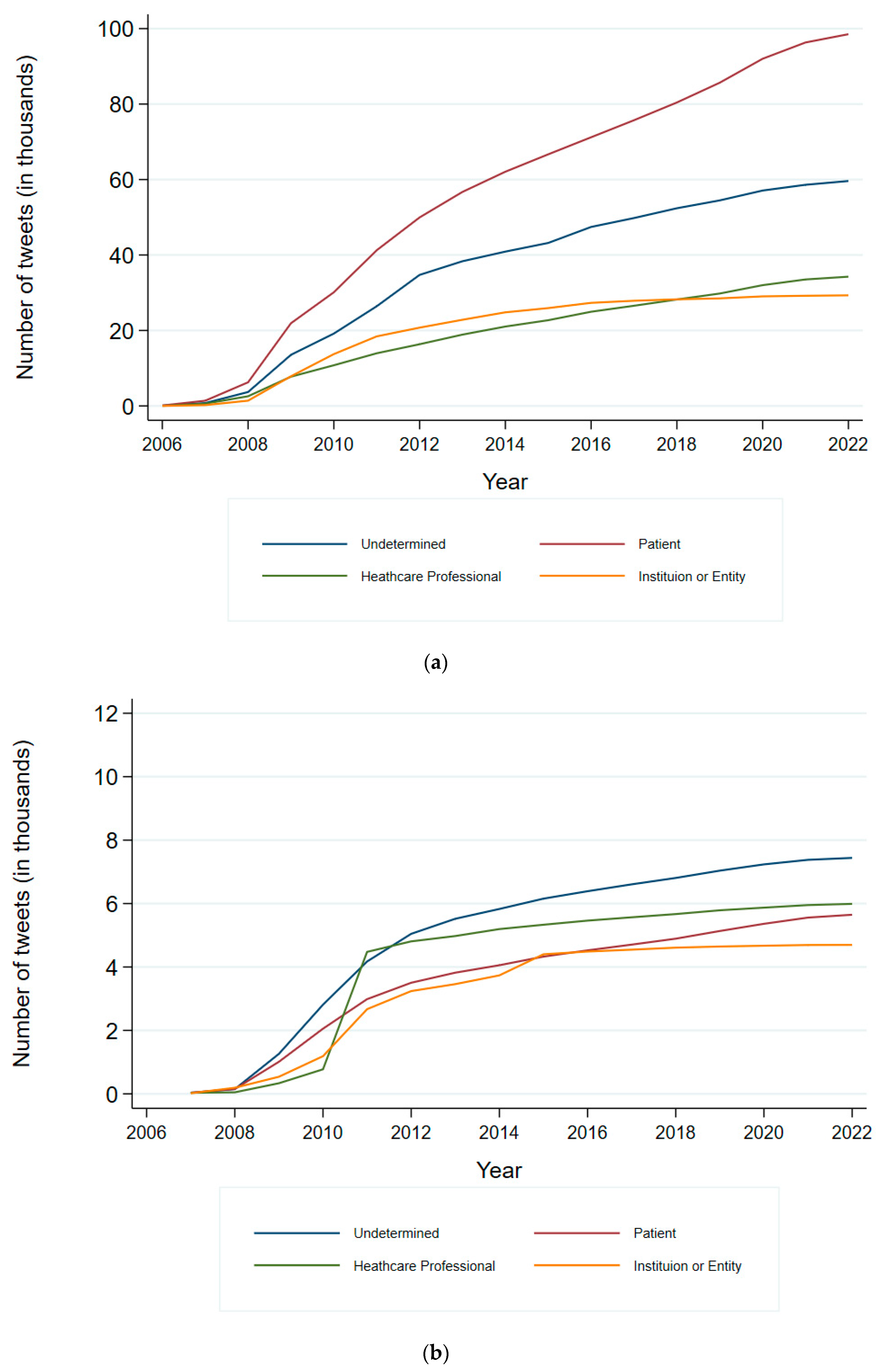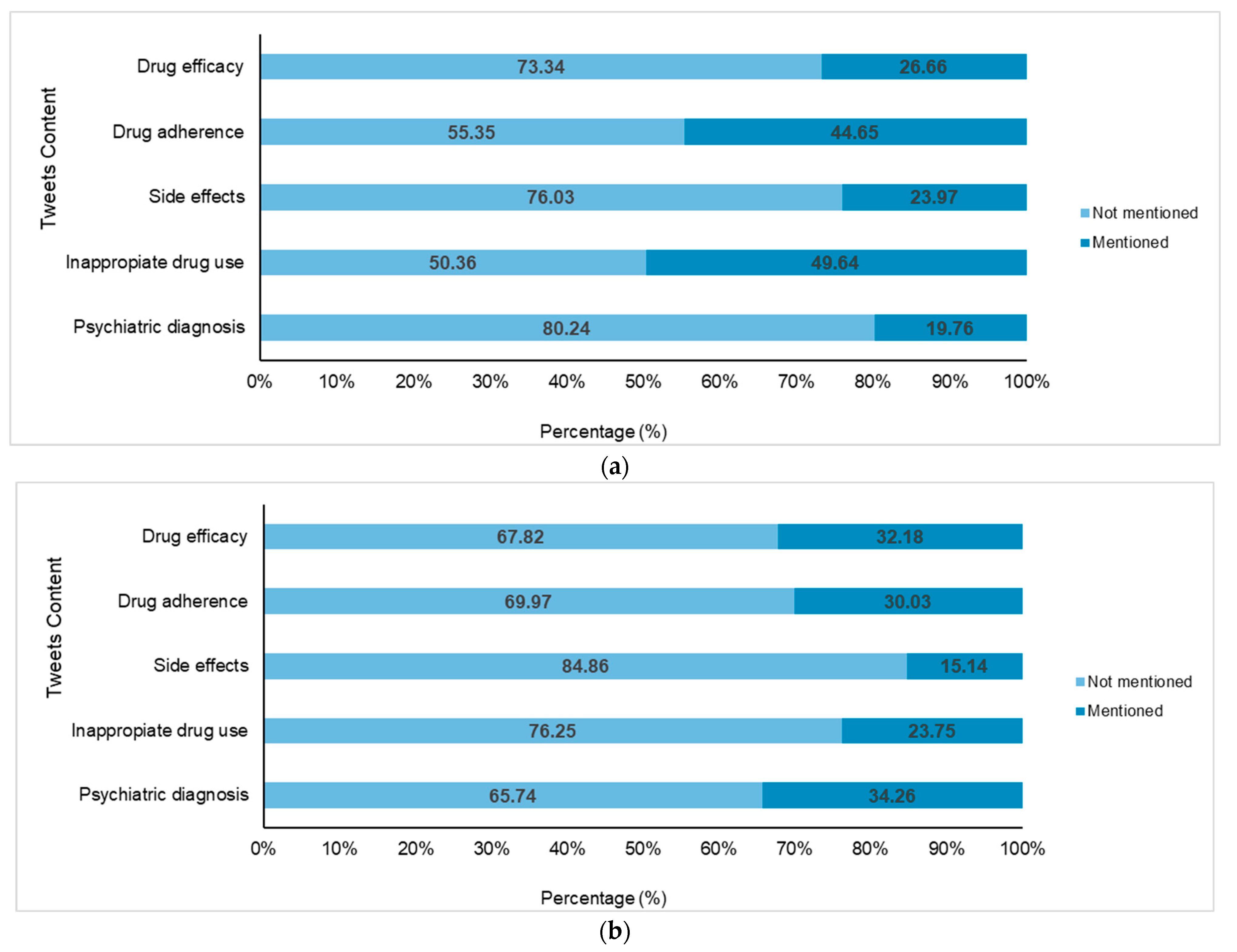Unveiling Social Media Content Related to ADHD Treatment: Machine Learning Study Using X’s Posts over 15 Years
Abstract
1. Introduction
2. Materials and Methods
2.1. X Data Collection Strategy
2.2. Content Analysis Process
2.2.1. Exploration of Data and Identification of Categories
2.2.2. Machine Learning Classifier
2.3. Statistical Analysis
2.4. Ethical Considerations
3. Results
3.1. Total Number of Tweets per Drug, Engagement and Temporal Evolution
3.2. User Type Analysis
3.3. Medical Content Analysis
3.4. Other Types of Content Analysis
4. Discussion
5. Conclusions
Supplementary Materials
Author Contributions
Funding
Data Availability Statement
Acknowledgments
Conflicts of Interest
References
- Faraone, S.V.; Banaschewski, T.; Coghill, D.; Zheng, Y.; Biederman, J.; Bellgrove, M.A.; Newcorn, J.H.; Gignac, M.; Al Saud, N.M.; Manor, I.; et al. The World Federation of ADHD International Consensus Statement: 208 Evidence-based conclusions about the disorder. Neurosci. Biobehav. Rev. 2021, 128, 789–818. [Google Scholar] [CrossRef]
- Sonuga-Barke, E.J.S.; Becker, S.P.; Bölte, S.; Castellanos, F.X.; Franke, B.; Newcorn, J.H.; Nigg, J.T.; Rohde, L.A.; Simonoff, E. Annual Research Review: Perspectives on progress in ADHD science—From characterization to cause. J. Child Psychol. Psychiatry 2023, 64, 506–532. [Google Scholar] [CrossRef]
- Fayyad, J.; Sampson, N.A.; Hwang, I.; Adamowski, T.; Aguilar-Gaxiola, S.; Al-Hamzawi, A.; Andrade, L.H.S.G.; Borges, G.; de Girolamo, G.; Florescu, S.; et al. The descriptive epidemiology of DSM-IV Adult ADHD in the World Health Organization World Mental Health Surveys. Atten. Deficit Hyperact. Disord. 2017, 9, 47–65. [Google Scholar] [CrossRef]
- Polanczyk, G.; de Lima, M.S.; Horta, B.L.; Biederman, J.; Rohde, L.A. The worldwide prevalence of ADHD: A systematic review and metaregression analysis. Am. J. Psychiatry 2007, 164, 942–948. [Google Scholar] [CrossRef]
- Coghill, D.; Hodgkins, P. Health-related quality of life of children with attention-deficit/hyperactivity disorder versus children with diabetes and healthy controls. Eur. Child Adolesc. Psychiatry 2016, 25, 261–271. [Google Scholar] [CrossRef]
- Able, S.L.; Johnston, J.A.; Adler, L.A.; Swindle, R.W. Functional and psychosocial impairment in adults with undiagnosed ADHD. Psychol. Med. 2007, 37, 97–107. [Google Scholar] [CrossRef]
- Ertan, C.; Özcan, Ö.Ö.; Pepele, M.S. Paediatric trauma patients and attention deficit hyperactivity disorder: Correlation and significance. Emerg. Med. J. EMJ 2012, 29, 911–914. [Google Scholar] [CrossRef]
- Østergaard, S.D.; Dalsgaard, S.; Faraone, S.V.; Munk-Olsen, T.; Laursen, T.M. Teenage Parenthood and Birth Rates for Individuals With and Without Attention-Deficit/Hyperactivity Disorder: A Nationwide Cohort Study. J. Am. Acad. Child Adolesc. Psychiatry 2017, 56, 578–584.e3. [Google Scholar] [CrossRef]
- Barkley, R.A.; Fischer, M.; Edelbrock, C.; Smallish, L. The adolescent outcome of hyperactive children diagnosed by research criteria--III. Mother-child interactions, family conflicts and maternal psychopathology. J. Child Psychol. Psychiatry 1991, 32, 233–255. [Google Scholar] [CrossRef]
- Young, S.; Moss, D.; Sedgwick, O.; Fridman, M.; Hodgkins, P. A meta-analysis of the prevalence of attention deficit hyperactivity disorder in incarcerated populations. Psychol. Med. 2015, 45, 247–258. [Google Scholar] [CrossRef]
- Karalunas, S.L.; Antovich, D.; Miller, N.; Nigg, J.T. Prospective prediction of developing internalizing disorders in ADHD. J. Child Psychol. Psychiatry 2023, 64, 768–778. [Google Scholar] [CrossRef]
- Posner, J.; Polanczyk, G.V.; Sonuga-Barke, E. Attention-deficit hyperactivity disorder. Lancet 2020, 395, 450–462. [Google Scholar] [CrossRef]
- Chan, A.Y.L.; Ma, T.-T.; Lau, W.C.Y.; Ip, P.; Coghill, D.; Gao, L.; Jani, Y.H.; Hsia, Y.; Wei, L.; Taxis, K.; et al. Attention-deficit/hyperactivity disorder medication consumption in 64 countries and regions from 2015 to 2019: A longitudinal study. EClinicalMedicine 2023, 58, 101780. [Google Scholar] [CrossRef]
- Caye, A.; Swanson, J.M.; Coghill, D.; Rohde, L.A. Treatment strategies for ADHD: An evidence-based guide to select optimal treatment. Mol. Psychiatry 2019, 24, 390–408. [Google Scholar] [CrossRef]
- Cortese, S.; Adamo, N.; Mohr-Jensen, C.; Hayes, A.J.; Bhatti, S.; Carucci, S.; Del Giovane, C.; Atkinson, L.Z.; Banaschewski, T.; Simonoff, E.; et al. Comparative efficacy and tolerability of pharmacological interventions for attention-deficit/hyperactivity disorder in children, adolescents and adults: Protocol for a systematic review and network meta-analysis. BMJ Open 2017, 7, e013967. [Google Scholar] [CrossRef]
- Bellato, A.; Perrott, N.J.; Marzulli, L.; Parlatini, V.; Coghill, D.; Cortese, S. Systematic Review and Meta-Analysis: Effects of Pharmacological Treatment for Attention-Deficit/Hyperactivity Disorder on Quality of Life. J. Am. Acad. Child Adolesc. Psychiatry 2024, 64, 346–361. [Google Scholar] [CrossRef]
- Fleming, M.; Fitton, C.A.; Steiner, M.F.C.; McLay, J.S.; Clark, D.; King, A.; Mackay, D.F.; Pell, J.P. Educational and Health Outcomes of Children Treated for Attention-Deficit/Hyperactivity Disorder. JAMA Pediatr. 2017, 171, e170691. [Google Scholar] [CrossRef] [PubMed]
- Keilow, M.; Holm, A.; Fallesen, P. Medical treatment of Attention Deficit/Hyperactivity Disorder (ADHD) and children’s academic performance. PLoS ONE 2018, 13, e0207905. [Google Scholar] [CrossRef] [PubMed]
- Polanczyk, G.V.; Willcutt, E.G.; Salum, G.A.; Kieling, C.; Rohde, L.A. ADHD prevalence estimates across three decades: An updated systematic review and meta-regression analysis. Int. J. Epidemiol. 2014, 43, 434–442. [Google Scholar] [CrossRef] [PubMed]
- Shellenberg, T.P.; Stoops, W.W.; Lile, J.A.; Rush, C.R. An update on the clinical pharmacology of methylphenidate: Therapeutic efficacy, abuse potential and future considerations. Expert Rev. Clin. Pharmacol. 2020, 13, 825–833. [Google Scholar] [CrossRef]
- Ferrin, M.; Häge, A.; Swanson, J.; Wong, K.H.T.W.; Dittmann, R.W.; Banaschewski, T.; Coghill, D.; Santosh, P.J.; Romanos, M.; Simonoff, E.; et al. Medication adherence and persistence in children and adolescents with attention deficit hyperactivity disorder (ADHD): A systematic review and qualitative update. Eur. Child Adolesc. Psychiatry 2024, 34, 867–882. [Google Scholar] [CrossRef]
- Handelman, K.; Sumiya, F. Tolerance to Stimulant Medication for Attention Deficit Hyperactivity Disorder: Literature Review and Case Report. Brain Sci. 2022, 12, 959. [Google Scholar] [CrossRef]
- Acosta, D.L.; Fair, C.N.; Gonzalez, C.M.; Iglesias, M.; Maldonado, N.; Schenkman, N.; Valle, S.M.; Velez, J.L.; Mejia, L. Nonmedical use of d-Amphetamines and Methylphenidate in Medical Students. P. R. Health Sci. J. 2019, 38, 185–188. [Google Scholar]
- Alfonso-Fuertes, I.; Alvarez-Mon, M.A.; Sanchez Del Hoyo, R.; Ortega, M.A.; Alvarez-Mon, M.; Molina-Ruiz, R.M. Time Spent on Instagram and Body Image, Self-esteem, and Physical Comparison Among Young Adults in Spain: Observational Study. JMIR Form. Res. 2023, 7, e42207. [Google Scholar] [CrossRef]
- Carabot, F.; Fraile-Martínez, O.; Donat-Vargas, C.; Santoma, J.; Garcia-Montero, C.; Pinto da Costa, M.; Molina-Ruiz, R.M.; Ortega, M.A.; Alvarez-Mon, M.; Alvarez-Mon, M.A. Understanding Public Perceptions and Discussions on Opioids Through Twitter: Cross-Sectional Infodemiology Study. J. Med. Internet Res. 2023, 25, e50013. [Google Scholar] [CrossRef]
- Chart-Pascual, J.P.; Montero-Torres, M.; Ortega, M.A.; Mar-Barrutia, L.; Zorrilla Martinez, I.; Alvarez-Mon, M.; Gonzalez-Pinto, A.; Alvarez-Mon, M.A. Areas of interest and sentiment analysis towards second generation antipsychotics, lithium and mood stabilizing anticonvulsants: Unsupervised analysis using Twitter. J. Affect. Disord. 2024, 351, 649–660. [Google Scholar] [CrossRef] [PubMed]
- Chart-Pascual, J.P.; Goena Vives, J.; Lara, F.; Montero Torres, M.; Marin Napal, J.; Muñoz, R.; García Montero, C.; Fraile Martínez, O.; Ortega, M.Á.; Salazar de Pablo, G.; et al. Understanding Social Media Discourse on Antidepressants: Unsupervised and Sentiment Analysis using X. Eur. Psychiatry J. Assoc. Eur. Psychiatr. 2025, 68, e51. [Google Scholar] [CrossRef]
- Alvarez-Mon, M.A.; Fernandez-Lazaro, C.I.; Ortega, M.A.; Vidal, C.; Molina-Ruiz, R.M.; Alvarez-Mon, M.; Martínez-González, M.A. Analyzing Psychotherapy on Twitter: An 11-Year Analysis of Tweets From Major U.S. Media Outlets. Front. Psychiatry 2022, 13, 871113. [Google Scholar] [CrossRef] [PubMed]
- de Anta, L.; Alvarez-Mon, M.A.; Donat-Vargas, C.; Lara-Abelanda, F.J.; Pereira-Sanchez, V.; Gonzalez Rodriguez, C.; Mora, F.; Ortega, M.A.; Quintero, J.; Alvarez-Mon, M. Assessment of beliefs and attitudes about electroconvulsive therapy posted on Twitter: An observational study. Eur. Psychiatry J. Assoc. Eur. Psychiatr. 2023, 66, e11. [Google Scholar] [CrossRef] [PubMed]
- Curtis, B.; Giorgi, S.; Buffone, A.E.K.; Ungar, L.H.; Ashford, R.D.; Hemmons, J.; Summers, D.; Hamilton, C.; Schwartz, H.A. Can Twitter be used to predict county excessive alcohol consumption rates? PLoS ONE 2018, 13, e0194290. [Google Scholar] [CrossRef]
- Sarker, A.; Gonzalez-Hernandez, G.; Ruan, Y.; Perrone, J. Machine Learning and Natural Language Processing for Geolocation-Centric Monitoring and Characterization of Opioid-Related Social Media Chatter. JAMA Netw. Open 2019, 2, e1914672. [Google Scholar] [CrossRef]
- Wang, S.; Ning, H.; Huang, X.; Xiao, Y.; Zhang, M.; Yang, E.F.; Sadahiro, Y.; Liu, Y.; Li, Z.; Hu, T.; et al. Public Surveillance of Social Media for Suicide Using Advanced Deep Learning Models in Japan: Time Series Study from 2012 to 2022. J. Med. Internet Res. 2023, 25, e47225. [Google Scholar] [CrossRef]
- Chen, L.; Jeong, J.; Simpkins, B.; Ferrara, E. Exploring the Behavior of Users With Attention-Deficit/Hyperactivity Disorder on Twitter: Comparative Analysis of Tweet Content and User Interactions. J. Med. Internet Res. 2023, 25, e43439. [Google Scholar] [CrossRef]
- Kim, M.G.; Kim, J.; Kim, S.C.; Jeong, J. Twitter Analysis of the Nonmedical Use and Side Effects of Methylphenidate: Machine Learning Study. J. Med. Internet Res. 2020, 22, e16466. [Google Scholar] [CrossRef]
- Alvarez-Mon, M.A.; Donat-Vargas, C.; Santoma-Vilaclara, J.; de Anta, L.; Goena, J.; Sanchez-Bayona, R.; Mora, F.; Ortega, M.A.; Lahera, G.; Rodriguez-Jimenez, R.; et al. Assessment of Antipsychotic Medications on Social Media: Machine Learning Study. Front. Psychiatry 2021, 12, 737684. [Google Scholar] [CrossRef]
- de Anta, L.; Alvarez-Mon, M.A.; Ortega, M.A.; Salazar, C.; Donat-Vargas, C.; Santoma-Vilaclara, J.; Martin-Martinez, M.; Lahera, G.; Gutierrez-Rojas, L.; Rodriguez-Jimenez, R.; et al. Areas of Interest and Social Consideration of Antidepressants on English Tweets: A Natural Language Processing Classification Study. J. Pers. Med. 2022, 12, 155. [Google Scholar] [CrossRef] [PubMed]
- Riese, F.M.; Keller, S. Supervised, Semi-supervised, and Unsupervised Learning for Hyperspectral Regression. In Hyperspectral Image Analysis: Advances in Machine Learning and Signal Processing; Prasad, S., Ed.; Springer Nature: Berlin/Heidelberg, Germany, 2020; pp. 187–232. [Google Scholar] [CrossRef]
- Nguyen, D.Q.; Vu, T.; Tuan Nguyen, A. BERTweet: A pre-trained language model for English Tweets. In Proceedings of the 2020 Conference on Empirical Methods in Natural Language Processing: System Demonstrations, Online, 16–20 November 2020; Liu, Q., Schlangen, D., Eds.; Association for Computational Linguistics: Stroudsburg, PA, USA, 2020; pp. 9–14. [Google Scholar] [CrossRef]
- de la Rosa, J.; Ponferrada, E.G.; Villegas, P.; Salas, P.G.D.P.; Romero, M.; Grandury, M. BERTIN: Efficient Pre-Training of a Spanish Language Model using Perplexity Sampling. arXiv 2022, arXiv:2207.06814. [Google Scholar] [CrossRef]
- Kulakowski, M.; Frasincar, F.; Cambria, E. Sentiment Classification of Cryptocurrency-Related Social Media Posts. IEEE Intell. Syst. 2023, 38, 5–9. [Google Scholar] [CrossRef]
- Tian, Y.; Zhang, W.; Duan, L.; McDonald, W.; Osgood, N. Comparison of pretrained transformer-based models for influenza and COVID-19 detection using social media text data in Saskatchewan, Canada. Front. Digit. Health 2023, 5, 1203874. [Google Scholar] [CrossRef] [PubMed]
- Abal, R.; Soria Quijaite, J.; Peña, L. Twitter Sentiment Analysis with Machine Learning for Political Approval Rating; Springer Nature: Berlin/Heidelberg, Germany, 2024; pp. 377–397. [Google Scholar] [CrossRef]
- Limaylla-Lunarejo, M.-I.; Condori-Fernandez, N.; Luaces, M.R. Requirements classification using FastText and BETO in Spanish documents. In Proceedings of the International Working Conference on Requirements Engineering: Foundation for Software Quality, Barcelona, Spain, 17–20 April 2023; Springer: Berlin/Heidelberg, Germany; pp. 159–176. [Google Scholar]
- Kim, M.G.; Kim, M.; Kim, J.H.; Kim, K. Fine-Tuning BERT Models to Classify Misinformation on Garlic and COVID-19 on Twitter. Int. J. Environ. Res. Public Health 2022, 19, 5126. [Google Scholar] [CrossRef]
- Wei, J.; Zou, K. EDA: Easy Data Augmentation Techniques for Boosting Performance on Text Classification Tasks. arXiv 2019, arXiv:1901.11196. [Google Scholar] [CrossRef]
- World Medical Association. World Medical Association Declaration of Helsinki: Ethical principles for medical research involving human subjects. JAMA 2013, 310, 2191–2194. [Google Scholar] [CrossRef]
- Raman, S.R.; Man, K.K.C.; Bahmanyar, S.; Berard, A.; Bilder, S.; Boukhris, T.; Bushnell, G.; Crystal, S.; Furu, K.; KaoYang, Y.-H.; et al. Trends in attention-deficit hyperactivity disorder medication use: A retrospective observational study using population-based databases. Lancet Psychiatry 2018, 5, 824–835. [Google Scholar] [CrossRef]
- Madsen, K.B.; Ersbøll, A.; Olsen, J.; Parner, E.; Obel, C. Geographic analysis of the variation in the incidence of ADHD in a country with free access to healthcare: A Danish cohort study. Int. J. Health Geogr. 2015, 14, 24. [Google Scholar] [CrossRef]
- Slobodin, O.; Masalha, R. Challenges in ADHD care for ethnic minority children: A review of the current literature. Transcult. Psychiatry 2020, 57, 468–483. [Google Scholar] [CrossRef]
- Yang, K.; Flores, M.; Carson, N.J.; Cook, B. Racial and Ethnic Disparities in Childhood ADHD Treatment Access and Utilization: Results From a National Study. Psychiatr. Serv. 2022, 73, 1338–1345. [Google Scholar] [CrossRef] [PubMed]
- Ramos-Quiroga, J.A.; Richarte, V.; Soto, I.; Targhetta, M.; Ward, J.; Perulero, N. The Prevalence and Treatment of ADHD in Spain: A Retrospective Cohort Analysis. J. Atten. Disord. 2023, 27, 273–282. [Google Scholar] [CrossRef]
- Boland, H.; DiSalvo, M.; Fried, R.; Woodworth, K.Y.; Wilens, T.; Faraone, S.V.; Biederman, J. A literature review and meta-analysis on the effects of ADHD medications on functional outcomes. J. Psychiatr. Res. 2020, 123, 21–30. [Google Scholar] [CrossRef]
- Pliszka, S.R.; Crismon, M.L.; Hughes, C.W.; Corners, C.K.; Emslie, G.J.; Jensen, P.S.; McCRACKEN, J.T.; Swanson, J.M.; Lopez, M. The Texas Children’s Medication Algorithm Project: Revision of the algorithm for pharmacotherapy of attention-deficit/hyperactivity disorder. J. Am. Acad. Child Adolesc. Psychiatry 2006, 45, 642–657. [Google Scholar] [CrossRef]
- Scheffler, R.M.; Hinshaw, S.P.; Modrek, S.; Levine, P. The global market for ADHD medications. Health Aff. Proj. Hope 2007, 26, 450–457. [Google Scholar] [CrossRef] [PubMed]
- Moran, L.V.; Ongur, D.; Hsu, J.; Castro, V.M.; Perlis, R.H.; Schneeweiss, S. Psychosis with Methylphenidate or Amphetamine in Patients with ADHD. N. Engl. J. Med. 2019, 380, 1128–1138. [Google Scholar] [CrossRef]
- Hamard, J.; Rousseau, V.; Durrieu, G.; Garcia, P.; Yrondi, A.; Sommet, A.; Revet, A.; Montastruc, F. Psychosis with use of amphetamine drugs, methylphenidate and atomoxetine in adolescent and adults. BMJ Ment. Health 2024, 27, e300876. [Google Scholar] [CrossRef] [PubMed]
- El Mundo. Empastillada con Concerta Para Aprobar los Últimos Exámenes; El Mundo: Madrid, Spain, 2024. [Google Scholar]
- US NEWS. ADHD Patients Could Face Disrupted Access to Meds Following Fraud; US NEWS: New York, NY, USA, 2024. [Google Scholar]
- Song, H.; Pei, X.; Liu, Z.; Shen, C.; Sun, J.; Liu, Y.; Zhou, L.; Sun, F.; Xiao, X. Pharmacovigilance in China: Evolution and future challenges. Br. J. Clin. Pharmacol. 2023, 89, 510–522. [Google Scholar] [CrossRef] [PubMed]
- Castillo, L.I.R.; Hadjistavropoulos, T.; Brachaniec, M. The Effectiveness of Social Media in the Dissemination of Knowledge About Pain in Dementia. Pain Med. Off. J. Am. Acad. Pain Med. 2021, 22, 2584–2596. [Google Scholar] [CrossRef] [PubMed]
- Faus, M.; Alonso, F.; Javadinejad, A.; Useche, S.A. Are social networks effective in promoting healthy behaviors? A systematic review of evaluations of public health campaigns broadcast on Twitter. Front. Public Health 2022, 10. [Google Scholar] [CrossRef]
- Alshaabi, T.; Dewhurst, D.R.; Minot, J.R.; Arnold, M.V.; Adams, J.L.; Danforth, C.M.; Dodds, P.S. The growing amplification of social media: Measuring temporal and social contagion dynamics for over 150 languages on Twitter for 2009–2020. EPJ Data Sci. 2021, 10, 15. [Google Scholar] [CrossRef]
- Slavin, S.D.; Berman, A.N.; Beam, A.L.; Navar, A.M.; Mittleman, M.A. Statin Twitter: Human and Automated Bot Contributions, 2010 to 2022. J. Am. Heart Assoc. 2024, 13, e032678. [Google Scholar] [CrossRef]





| Variable | Category and Explanation | Example |
|---|---|---|
| User type | Patient: Tweets where the author explicitly identified themselves as someone diagnosed with ADHD or currently using ADHD medications, sharing their personal experiences, struggles, or reflections related to treatment. | I was off work for 5 months. Going to counselling and seeing an OT for my cognitive challenges. Diagnosed with ADHD started vyvanse and was able to do a gradual return to work. My concentration was shot. My memory was now terrible. My once so capable brain was not familiar now. |
| User type | Healthcare professionals: Tweets written by individuals who explicitly self-identified as healthcare providers, usually discussing prescribing practices, clinical experiences, or medical observations about ADHD treatments. When possible, we also cross-checked the user’s biography for references to professional roles such as ‘Dr,’ ‘nurse,’ ‘therapist,’ or similar identifiers to support the classification. | I can’t imagine prescribing someone Dexedrine without an ADHD diagnosis and something like maybe narcolepsy. To put it in perspective Hunter S Thompson used to write frequently about Dexedrine 50+ years ago it’s an old drug with worse side effects than modern alternatives. |
| User type | Healthcare institutions: Tweets from verified or institutionally branded accounts, such as public health organisations, medical associations, or clinics, providing general medical advice, warnings, or news about ADHD medications. | Methylphenidate: safe and effective use to treat ADHD: Updated guidance to use methylphenidate to safely and… |
| Content | Efficacy: Tweets describing perceived effectiveness of ADHD medications, based on the author’s personal or observed experiences with symptom improvement or treatment response. | Concerta really works for me and it lasts for 8 h 😁 I would recommend talking to your therapist about trying it out! |
| Content | Inappropriate use: Tweets explicitly describing non-therapeutic or risky consumption patterns—for example, combining ADHD medications with alcohol or illicit drugs, or using them episodically to stay awake for long hours. | a lot of people have been asking me how I manage 2 tweet around the clock ⏰ amphetamine methylphenidate dextroamphetamine + red bull I popped Concerta a Vicodin Adderall drunk some whiskey Vodka smoked 3 blunts smoked a black…and now. |
| Content | Side effects: Tweets detailing negative physiological or psychological reactions to ADHD medications, including tolerability issues, physical symptoms, or emotional effects. | Concerta made me feel like a zombie. Vyvanse made my joint problems worse… |
| Content | Psychiatric diagnosis: Tweets that explicitly mentioned ADHD, either in relation to other psychiatric conditions, comorbidities, or the combined effects of ADHD and non-ADHD medications. | I was on Paxil now I’m on Sertraline for my anxiety. For my ADHD I was on Strattera & Intuniv those failed so now I’m on Vyvanse. I believe the Vyvanse and/or the Sertraline are causing me to have mood swings and anx. atks. though my anxiety and concentration is a little better |
| Content | Economic and legal activities: Tweets describing financial or insurance barriers to accessing medications, price concerns, or navigating regulatory steps such as titration or authorisation processes. | Oh God I switched from Concerta to Jornay PM and the insurance made me step titrate for the first time in 10 years and it was hellish. Like yeah lets take 30% of this drug I need daily. That will work |
| Content | Advocacy: Tweets advocating for specific treatments, sharing epidemiological warnings, or explaining pharmacological mechanisms to raise awareness or caution. | Observational non randomised data (use caution) show higher risk of #psychosis if #ADHD patients provided amphetamine-based medicines (#Adderall & #Vyvanse) instead of meds based on methylphenidate (#Ritalin or #Concerta) |
| Content | Request and offer: Tweets explicitly requesting or offering ADHD medications, either through formal channels or illicitly. | Buy strattera online… ADHD medications vyvanse. Click Here To Enter… |
| Content | Trivialisation: Tweets using ADHD medications in jokes, memes, or sarcastic remarks, often reflecting cultural trivialisation or stereotyping of ADHD treatment. | Hey Donald how’s that addiction to Adderall going? |
| Total Original Tweets (English + Spanish) | English Original Tweets | Spanish Original Tweets | ||||||||||
|---|---|---|---|---|---|---|---|---|---|---|---|---|
| Drug | n (Frequency) | % (Percentage) | Ratio Like:Tweet | Ratio Retweet:Tweet | n (Frequency) | % (Percentage) | Ratio Like:Tweet | Ratio Retweet:Tweet | n (Frequency) | % (Percentage) | Ratio Like:Tweet | Ratio Retweet:Tweet |
| Stimulants | 183,571 | 74.78 | 97.68 | 16.33 | 166,726 | 75.21 | 106.98 | 17.81 | 16,845 | 70.86 | 5.65 | 1.74 |
| Amphetamine | 14,136 | 5.76 | 43.30 | 10.34 | 12,073 | 5.45 | 50.02 | 11.89 | 2063 | 8.68 | 3.99 | 1.30 |
| Dextroamphetamine | 43,779 | 17.83 | 374.25 | 61.59 | 43,457 | 19.60 | 376.97 | 62.03 | 322 | 1.35 | 6.77 | 2.40 |
| Lisdexamfetamine | 11,432 | 4.66 | 21.69 | 1.90 | 9437 | 4.26 | 26.08 | 2.24 | 1995 | 8.39 | 0.96 | 0.26 |
| Methylphenidate | 114,224 | 46.53 | 6.02 | 1.17 | 101,759 | 45.90 | 5.94 | 1.07 | 12,465 | 52.44 | 6.65 | 2.04 |
| Non-stimulants | 61,896 | 25.22 | 13.49 | 2.87 | 54,969 | 24.79 | 15.04 | 2.87 | 6927 | 29.14 | 1.18 | 2.87 |
| Atomoxetine | 41,007 | 16.71 | 1.85 | 0.35 | 37,782 | 17.04 | 1.91 | 0.25 | 3225 | 13.57 | 1.12 | 1.55 |
| Guanfacine | 8918 | 3.63 | 1.57 | 0.19 | 7310 | 3.30 | 1.84 | 0.19 | 1608 | 6.76 | 0.38 | 0.19 |
| Viloxazine | 1462 | 0.60 | 0.88 | 0.10 | 1438 | 0.65 | 0.88 | 0.09 | 24 | 0.10 | 0.96 | 0.83 |
| Clonidine | 10,509 | 4.28 | 70.75 | 15.33 | 8439 | 3.81 | 87.64 | 17.37 | 2070 | 8.71 | 1.91 | 7.03 |
| Total | 245,467 | 100 | 221,695 | 100 | 23,772 | 100 | ||||||
Disclaimer/Publisher’s Note: The statements, opinions and data contained in all publications are solely those of the individual author(s) and contributor(s) and not of MDPI and/or the editor(s). MDPI and/or the editor(s) disclaim responsibility for any injury to people or property resulting from any ideas, methods, instructions or products referred to in the content. |
© 2025 by the authors. Licensee MDPI, Basel, Switzerland. This article is an open access article distributed under the terms and conditions of the Creative Commons Attribution (CC BY) license (https://creativecommons.org/licenses/by/4.0/).
Share and Cite
Gómez-Prieto, A.; Mercado-Rodriguez, A.; Chart-Pascual, J.P.; Fernandez-Lazaro, C.I.; Lara-Abelenda, F.J.; Montero-Torres, M.; Aymerich, C.; Quintero, J.; Alvarez-Mon, M.; Gonzalez-Pinto, A.; et al. Unveiling Social Media Content Related to ADHD Treatment: Machine Learning Study Using X’s Posts over 15 Years. Healthcare 2025, 13, 2487. https://doi.org/10.3390/healthcare13192487
Gómez-Prieto A, Mercado-Rodriguez A, Chart-Pascual JP, Fernandez-Lazaro CI, Lara-Abelenda FJ, Montero-Torres M, Aymerich C, Quintero J, Alvarez-Mon M, Gonzalez-Pinto A, et al. Unveiling Social Media Content Related to ADHD Treatment: Machine Learning Study Using X’s Posts over 15 Years. Healthcare. 2025; 13(19):2487. https://doi.org/10.3390/healthcare13192487
Chicago/Turabian StyleGómez-Prieto, Alba, Alejandra Mercado-Rodriguez, Juan Pablo Chart-Pascual, Cesar I. Fernandez-Lazaro, Francisco J. Lara-Abelenda, María Montero-Torres, Claudia Aymerich, Javier Quintero, Melchor Alvarez-Mon, Ana Gonzalez-Pinto, and et al. 2025. "Unveiling Social Media Content Related to ADHD Treatment: Machine Learning Study Using X’s Posts over 15 Years" Healthcare 13, no. 19: 2487. https://doi.org/10.3390/healthcare13192487
APA StyleGómez-Prieto, A., Mercado-Rodriguez, A., Chart-Pascual, J. P., Fernandez-Lazaro, C. I., Lara-Abelenda, F. J., Montero-Torres, M., Aymerich, C., Quintero, J., Alvarez-Mon, M., Gonzalez-Pinto, A., Soutullo, C. A., & Alvarez-Mon, M. A. (2025). Unveiling Social Media Content Related to ADHD Treatment: Machine Learning Study Using X’s Posts over 15 Years. Healthcare, 13(19), 2487. https://doi.org/10.3390/healthcare13192487









